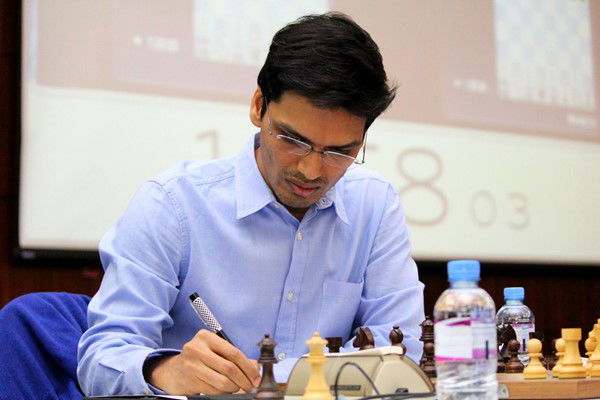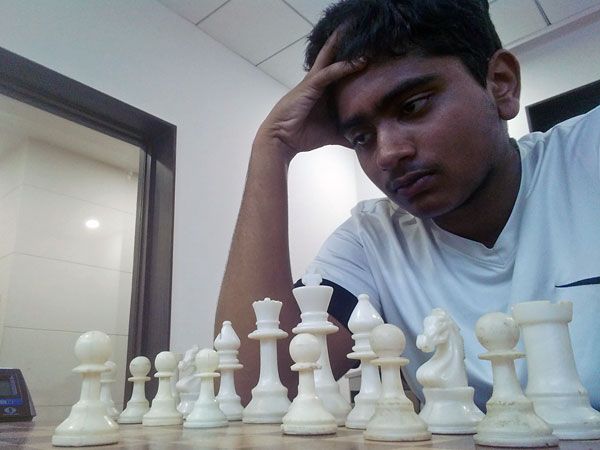Geneva Grand Prix Round 5: Grischuk joins Radjabov in the lead; Hari draws Nepomniachtchi
GM Teimour Radjabov had been the sole leader at the Geneva Grand Prix since the second round and was being closely chased by six players including India's Pentala Harikrishna. In round 5 of the tournament, Radjabov conceded his third consecutive draw and gave the players sharing the second spot a chance to catch him in the lead. Although only Aronian was able to win his game and join the Azeri on the first spot, the round featured some intense battles.
Halfway down the line at the Geneva Grand Prix, tournament leader, Teimur Radjabov continued his streak of draws. In round 5, he drew his game against his countryman Shakhriyar Mamedyarov. A field of six players, who were half a point behind him, now had the opportunity to catch Radjabov in the lead. Alexander Grischuk, who was one of the six players trailing behind Radjabov made the most of this opportunity by winning his game against Pavel Eljanov.
Harikrishna too had the same opportunity as Grischuk given that here was only a mere half point behind Radjabov. Hari opened the game yet another time with a king pawn advance. Had Nepomniachtchi played 1. e5, maybe Hari would have gone for the rock solid Italian. But Nepo wasn’t having any of it. He went for the sharpest variation of the Sicilian Defence – the Najdorf. This clearly was a way of testing the Indian’s temperament given that he has exclusively played the Italian in this tournament. But Hari was apparently up for the task and blitzed out the first fifteen moves showing that he was thoroughly prepared. He chose the 5. h3 setup against the Nepo’s Najdorf – a line which is extremely topical at the moment – and the game turned wild very soon.

Harikrishna too had the same opportunity as Grischuk given that here was only a mere half point behind Radjabov. Hari opened the game yet another time with a king pawn advance. Had Nepomniachtchi played 1. e5, maybe Hari would have gone for the rock solid Italian. But Nepo wasn’t having any of it. He went for the sharpest variation of the Sicilian Defence – the Najdorf. This clearly was a way of testing the Indian’s temperament given that he has exclusively played the Italian in this tournament. But Hari was apparently up for the task and blitzed out the first fifteen moves showing that he was thoroughly prepared. He chose the 5. h3 setup against the Nepo’s Najdorf – a line which is extremely topical at the moment – and the game turned wild very soon.
With kings castled on opposite wings, both Nepo and Hari flung their pawns forward to storm the enemy monarch. On his 17th move, Hari went into a 30-minute long think and came out with a very enterprising idea. Going by general principles of chess, it isn’t advisable to move pawns on the side where one is being attacked. But Hari did exactly that! He attacked the Russian’s knight with his queen knight pawn. The engines didn’t seem to be particularly impressed by this and almost screamed that black should sacrifice the attacked night and lash out with a counter attack. But Nepo chose to take it slow and allowed Hari to find counter chances. After a few skirmishes in the middle game, Hari temporarily sacrificed an exchange and steered the game into a rook and pawn endgame with an extra pawn. However, this extra pawn was far from the healthiest. As compensation, Nepomniachtchi had sufficient piece activity. Not to mention, all the pawns were on the same side of the board, which meant that a draw was inevitable. The players signed peace on the 51st move.
[Site "Geneva"]
[Date "2017.07.10"]
[Round "5"]
[White "Harikrishna, Pentala"]
[Black "Nepomniachtchi, Ian"]
[Result "1/2-1/2"]
[ECO "B81"]
[WhiteElo "2737"]
[BlackElo "2742"]
[Annotator "Tanmay Srinath"]
[PlyCount "102"]
[EventDate "2017.??.??"]
{This 5th Round Game was an interesting pairing. On one hand we have the solid
Harikrishna, who's unbeaten this tournament, and on the other hand we have Ian
Nepomniachtchi, a super aggressive 'risk it all' player. This game lived up to
the hype, and we had an uncompromising struggle.} 1. e4 {Hari has stuck to e4
in this tournament. He is one of the few really good ambidextrous players,
being able to play both e4 and d4 really well. I guess he predicted Nepo's
opening choice, and decided he wanted to go all out today.} c5 {The Sicilian
has always been a popular opening at the top level for aggressive players like
Kasparov, Topalov etc. Nepo continues this trend.} 2. Nf3 d6 3. d4 {This time,
we don't see a Rossolimo, that happens after Bb5. It is now a fight of good
opening preparation.} (3. Bb5+ {This is becoming more and more popular at the
top level for people who don't want to enter 20 moves of prepared theory. Nepo
himself faced it twice this year against Najdorf expert Vacher Lagrave, and
lost both. One of those games continued} Nd7 4. O-O a6 5. Bd3 b5 6. Re1 Bb7 7.
a4 b4 8. Bc4 Ngf6 9. d3 e6 10. Nbd2 Be7 11. Nf1 O-O 12. Ng3 $13 {with an
unclear position, though Maxime eventually won.}) 3... cxd4 4. Nxd4 Nf6 5. Nc3
a6 {The Najdorf is the most common Sicilian at the top level, due to its blend
of tactical and positional themes. It is also Nepo's favourite.} 6. h3 {
This move is the tabiya of modern chess. White refuses to commit to any DS
Bishop moves, and plans to fianchetto the bishop after g4. His main aim is to
control the light squares that Black will weaken if he plays e5. His idea is
to play Nde2 after e5.} (6. Be2 {was a move that was frequently used, but has
now been relegated, due to the efforts of Maxime and other Najdorf experts.
The point is that the bishop is well placed to reach f3 if black plays e6,
allowing white to expand unhindered on the kingside with f4. However, after e5,
it is clear that the bishop is slightly misplaced. A playable variation
nevertheless, but it has lost some trust at the top level. I will mention a
sample line now. After} e5 7. Nb3 Be7 8. O-O O-O 9. Qd3 Nc6 {and black faces
few difficulties, and eventually drew, Ponomariov-Shankland. It speaks volumes
of the variation if white has scored only 51% in it.}) (6. Be3 {is the English
Attack. Here too white will play g4, but after f3. However, this move order
has a disavantage. After} e5 7. Nb3 Be6 8. f3 {Black has been doing very well
recently with the move} h5 {The point is to prevent the freeing g4.
Topalov-Vachier Lagrave continued} 9. Qd2 Nbd7 10. Nd5 Bxd5 11. exd5 g6 12. Be2
Bg7 {and black is doing fine.}) (6. Bg5 {A once popular variation, that went
under the cloud because of the forced Poisoned Pawn lines. This is white's
most aggressive way to fight the Najdorf. Parimarjan Negi has written an
excellent book on the subject, and I won't be surprised if the variation is
revived at the top level, partly due to Fabiano's recent efforts.
Caruana-Nakamura continued} e6 7. f4 h6 8. Bh4 Qb6 9. a3 Be7 10. Bf2 Qc7 11.
Qf3 Nbd7 12. O-O-O b5 13. g4 g5 14. h4 gxf4 15. Be2 b4 16. axb4 Ne5 17. Qxf4
Nexg4 18. Bxg4 e5 {and here Fabi unleased the fantastic} 19. Qxf6 $3 {and won
later}) 6... e6 {Nepo chooses to play the Scheveningen today.} (6... e5 {
is slightly more popular at the top level. Play continues} 7. Nde2 h5 8. Bg5
Be6 9. Bxf6 Qxf6 10. Nd5 Qd8 11. Nec3 {and white has slightly better chances,
Anand-Bologan.}) 7. g4 {This is the reason the Scheveningen has disappeared
from the top level- the aggressive Keres Attack. So unless Nepo has cooked up
something new, he is staring at trouble.} Be7 8. g5 Nfd7 9. h4 b5 10. a3 Bb7
11. Be3 Nc6 12. Qd2 O-O 13. O-O-O Nc5 14. f3 Rb8 {Both sides complete their
development in standard fashion. I feel the assesment of the position will
depend on who crashes through first.} 15. Kb1 $146 {A natural move that is
also a novelty.} (15. Rg1 {is its predecessor. But after} b4 16. Nxc6 Bxc6 17.
axb4 Qb6 $132 {Black finds immediate counterplay, and white has to be careful
here.}) 15... Nxd4 16. Bxd4 Bc6 17. Bh3 $6 {A very questionable decision, but
a human one after all. I guess Hari was out of his preparation at this point.}
({It was necessary for Karpovian prophylaxix with} 17. b4 $1 {physically
stopping black from playing the same. White is taking a risk here, as a timed
a5 might shatter his structure, but then, why play the sicilian if you don't
want to take risks? After} Qc7 18. h5 a5 19. g6 $14 {White is crashing through
first, though black still has chances.}) 17... a5 {Nepo takes the chance
offered to him, and the game now turns very sharp.} 18. b4 $6 {I think this is
one move too late, and allows back to improve his c5 knight and open the
a-file.} (18. Qe3 {Was necessary, to threathen Bxc5. After} b4 19. Bxc5 bxc3
20. Qxc3 Rc8 21. e5 Bxf3 22. Qxf3 Rxc5 {White has somewhat stabilised the
situation.}) 18... axb4 19. axb4 Nd7 {A bad move by Nepo. Why retreat when you
can advance} (19... Na4 $1 {was possible, to cover important squares on the
queenside. After} 20. Nxa4 bxa4 21. Ka1 Qc7 22. h5 e5 $1 $17 {Black is calling
the shots.}) 20. g6 $1 {Hari takes the gift presented to him, and attacks
gleefully.} e5 21. gxf7+ Rxf7 22. Be3 Kh8 23. Rhg1 Nb6 24. Be6 $2 {A bad move.
White hurries through with his plan, forgetting that there was a better move
to me made.} (24. Bxb6 $1 {Was the move required to maintain equality. After}
Rxb6 {now it is right to play} 25. Be6 Rf6 26. Bd5 Qf8 27. Kb2 {and white can
look forward to a long and interesting game.}) 24... Nc4 $1 25. Qe2 Rf6 $6 {
Now, this is a clear inaccuracy. Why force the bishop back when that is all it
can do?} (25... Qf8 $1 {is the best move here, improving the queen. After} 26.
Nd5 (26. Bxf7 {Note that Bxf7 is clearly bad after} Qxf7 27. Qf2 Ra8 28. f4 Bf6
$40 {Threathening the queen transfer to a7 and mate on a1. Black is close to
winning.}) 26... Bd8 27. Rdf1 Ra8 $17 {Black can start thinking on how to win
this position.}) 26. Bxc4 $1 {Hari sees light at the end of the tunnel, and
quickly liquidates.} bxc4 27. Qxc4 Qa5 $4 {A blunder at this level. Black is
playing 'normal' attacking moves, and doesn't care if he loses a piece.
However, he is getting just one or two checks.} (27... Qe8 {is the way to go
according to Houdini, and play on both flanks. After} {Houdini 5.01 Pro x64:}
28. Kc1 Rxf3 29. Rd3 Bf8 30. h5 Bd7 31. h6 g6 32. Bg5 Rf2 $17 {Black retains
his advantage.}) 28. Kc1 $2 {Again, Harikrishna falls to a bluff by the black
player! A timid move by a really strong player. I guess he was already in
slight time trouble at this point.} (28. Qxc6 {and Black is close to lost, the
point being that after} Qxb4+ 29. Kc1 d5 30. Qc7 d4 31. Nd5 Qb2+ 32. Kd2 dxe3+
33. Ke2 $18 {White escapes to the kingside, and starts creating strong threats}
) 28... Qa3+ {Nepo is not the one to give another chance!} 29. Kd2 d5 30. exd5
Bxb4 31. dxc6 Bxc3+ 32. Ke2 Bd4 33. Rd3 Qa8 {The last few moves have been more
or less forced. However, Nepo's last move allows Hari to sack an exchange
succesfully.} ({Better to play} 33... Qd6 {here and stop Rxd4 ideas. After} 34.
c7 Rc8 35. f4 Qf8 36. Bxd4 exd4 37. Rxd4 Qe7+ 38. Re4 Qd7 {Black holds the
balance, but only just.}) 34. Rxd4 $1 {A really good move, the best in the
position. Hari gets a strong passer and two pawns for this exchange sac. Also,
the black king is now exposed on the long diagonal.} exd4 35. Bxd4 Re8+ 36. Kf2
Qxc6 {Nepo tries his best, and exchanges queens to halt the assault} 37. Qxc6
Rxc6 38. Rxg7 Rxc2+ 39. Kg3 Rc4 40. Rg4+ Rxd4 $1 {The final good sacrifice of
the game. Black directs the game into a pawn down rook ending that he should
draw.} 41. Rxd4 Kg7 42. Kg4 Re1 43. Rd7+ Kh6 44. Rd6+ Kg7 45. f4 Rg1+ 46. Kf5
h5 47. Rd7+ Kg8 48. Ke6 Rg6+ 49. Ke5 Rg4 50. f5 Rxh4 51. Rd8+ Kf7 {And the
players agree to a draw. Another volatile game by Nepo, where he had the
chances, but failed to take advantage of them. Hari on the other hand will be
left fuming after missing another glorious chance(Qxc6). Also, I feel that he
should really reduce his inaccuracies in critical moments. Once he improves
his conversion rate, no one can stop him.} 1/2-1/2







Replay all the games:
